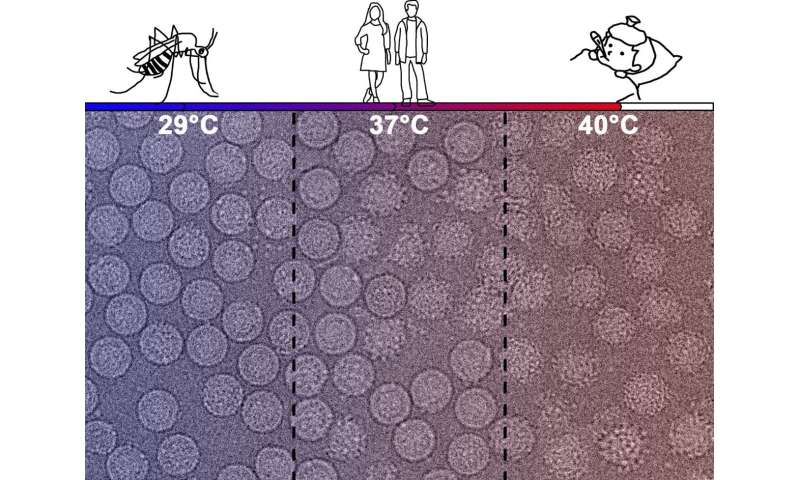Dengue virus becoming resistant to vaccines and therapeutics due to mutations in specific protein

Researchers from Duke-NUS Medical School (Duke-NUS), in collaboration with the Agency for Science, Technology and Research (A*STAR)’s Bioinformatics Institute (BII), and the University of Texas Medical Branch (UTMB), U.S., have discovered that the dengue virus changes its shape through mutations in Envelope (E) protein to evade vaccines and therapeutics. The study also gives insights on the types of treatment strategies to use at different stages of infection. This could give rise to new approaches in vaccine development and treatment for dengue disease.
Dengue virus (DENV) infects about 400 million people annually around the world, with a high prevalence in tropical and sub-tropical regions. The virus causes diseases ranging from mild dengue fever to severe dengue hemorrhagic fever and dengue shock syndrome.
DENV2 exists as smooth spherical surface particles while growing at the mosquito’s physiological temperature (29 degrees Celsius). It then changes to bumpy surfaced particles at human physiological temperature (37 degrees Celsius). This ability to morph helps the virus to evade the immune system of the human host. Hence, understanding the mechanism behind this is important for therapeutics and vaccine development.
“Together with Professor Pei-Yong Shi from UTMB, we found that in laboratory developed DENV2 strains, mutations in the virus’ E protein causes its transformation into bumpy particles. These structural changes can cause vaccines and therapeutics to be ineffective against the virus,” said Ms Xin-Ni Lim, the study’s lead author who is from Duke-NUS’ Emerging Infectious Diseases (EID) Programme.
The team also tested four DENV2 strains obtained from patients. They observed that in contrast to the laboratory adapted viruses, the majority of these clinical strains maintained smooth surface structure at 37 degrees Celsius. However, at 40 degrees Celsius, the temperature of a fever, all virus strains took on a bumpy surface.
“Our study gives a new direction to vaccine development and treatment for dengue disease. For prevention of disease through vaccines that are administered to the patient before dengue infection, we should use those that are effective against the smooth surface virus. When it comes to patients displaying fever symptoms, treatment strategies effective against the bumpy surface particles should be implemented,” said Dr. Sheemei Lok, Professor, Duke-NUS’ EID and corresponding author of this study.
“This study is a first step towards gaining more insight into how DENV2 reacts and adapts to the host’s immunological defenses. We were also able to use computational modeling approaches to predict why particles from different DENV2 strains are more or less adept at morphing from the smooth to bumpy structures. By better understanding the interactions between the virus and the host, we will be able to develop better therapies and vaccines to treat or prevent infections, and contribute to public health outcomes,” said Dr. Peter Bond, Principal Investigator from A*STAR’s BII.
Source: Read Full Article


